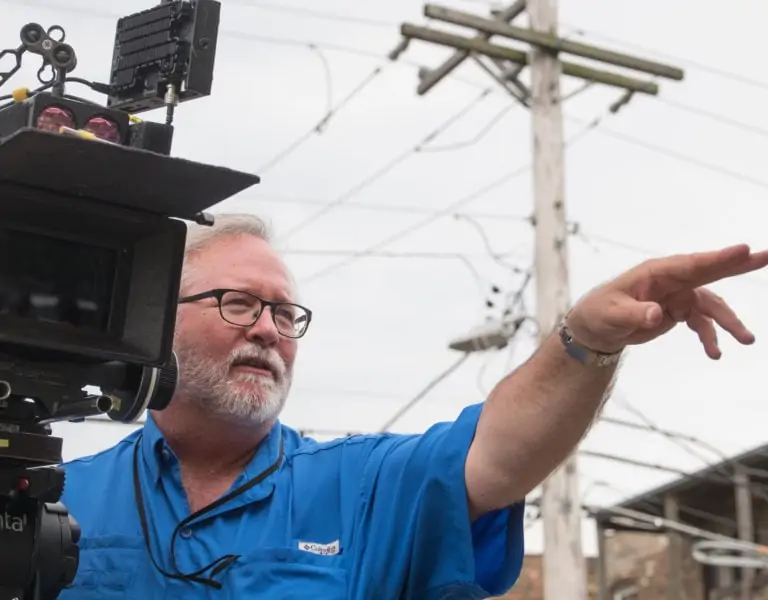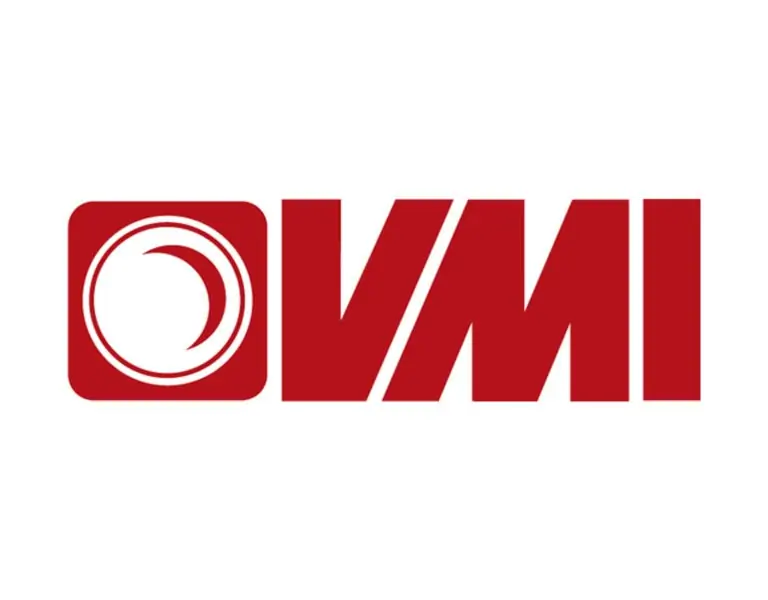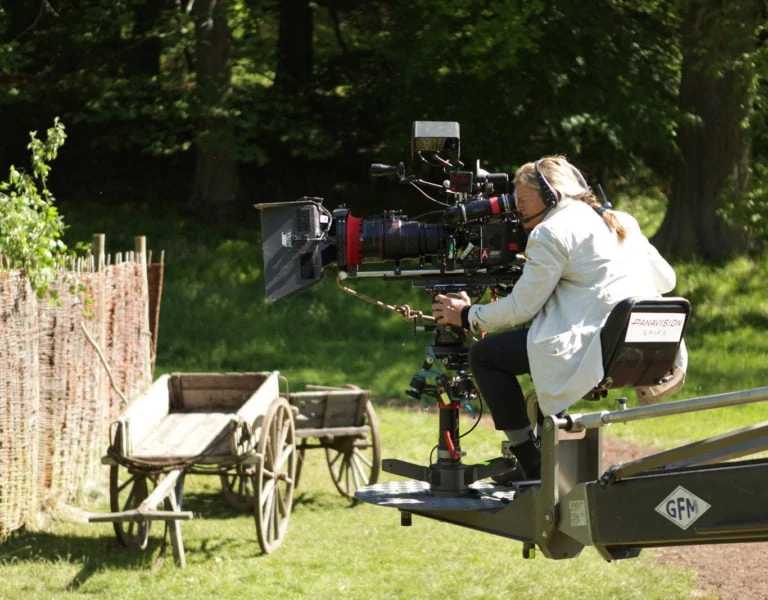SHINING EXAMPLE
Selected Filmography (as gaffer, unless otherwise stated)
Tom Jones (David Mackie, 2022)
The Northman (Jarin Blaschke, 2022)
Dalgleish (Angus Mitchell, 2021)
The Deceived (Donna Wade, 2020)
Mrs Wilson (Hubert Taczanowski, 2018)
Krypton (Christopher Baffa ASC, 2019)
Marcella (Sam Care, 2018)
Doing Money (Neus Ollé BSC AEC, 2018)
Woman in White (Eben Bolter BSC, 2018)
Derry Girls (Oli Russell, 2018)
Paula (Stephan Pehrsson BSC, 2017)
The Fall (Dave Grennan, 2016)
The Lost City of Z (Darius Khondji AFC ASC, 2016)
The Journey (Gregory Gardiner, 2016)
Morgan (Mark Patten BSC, 2015)
The Good Man (Angus Mitchell, 2013)
TT 3D Closer to the Edge (Thomas Kürzl, 2011)
The Race (Dirk Morgenstern, 2009)
What inspired you to become a gaffer?
To be honest, I never set out to be a gaffer. From an early age I was fascinated by electricity and how it was generated. I guess I was always going to work in that field, but gaffering was something that happened to me rather than something I wanted to happen. Who was it that said: ‘Life is what happens when you’re making other plans.’ It was a bit like that.
How and where did you learn the craft?
I was between jobs as an electrical construction foreman in the mid-‘90s when I got a phone call from my brother, (actor/producer) John Lynch. His production company was making a film in Wicklow, Ireland. They were bringing in a German lighting designer called Helmut Prein and John wanted to know if I would work for Helmet as his assistant on the project.
Little did I know that my decision to say yes would change forever the direction of my career. The film was called This is the Sea and was gaffered by the enigmatic Gerry Donnelly from Dublin. Gerry and I became friends, and he was instrumental in me obtaining my Union card in Dublin and making the transition from construction to film. The more I worked in film, the more I learnt. The more I learnt, the more I loved what I did.
Who or what were your biggest inspirations or mentors?
Gerry Donnelly would regale me into small hours, in his home in the Wicklow mountains, with stories of London studios, of films he had worked on, of the subtleties of light, shadow and shade. Our conversations were punctuated with Cognac, Cuban cigars, and bottles of Cava. I miss those nights and I miss Gerry.
In 2002, Belfast gaffer Brian Livingstone crewed me in a film called Puckoon. This would start a working relationship that would last over 10 years. I learnt a lot from Brian over this period. I will be forever grateful for the patience, understanding, and friendship he has shown me.
In 2015, I was chosen by Darius Khondji ASC AFC to gaffer The Lost City of Z. My collaboration with Darius changed my whole perspective on lighting. He taught me the nuances of using an F-stop meter, contrast ratio, and to stand where the actor would stand; ‘feel the light that they feel’, he would say. The walls of his office were adorned with pictures of paintings by Dutch masters – Rembrandt, Vermeer and Terbruggen were all celebrated. ‘We must strive for this beauty’, he would plead. Darius is an artist, a 21st-century master. He lights with his very soul. I think of him often.
In 2020, I met a cinematographer called Jarin Blaschke. We discussed how we were going to light a 12th-century Nordic adventure called The Northman. This journey was to last over a year and was to become my biggest challenge yet.
Jarin is technically brilliant, bordering on genius, and I am definitely not. I had to do a lot of research just to keep up. He wanted hard, crisp shadows from his moonlight, a realistic fire flicker created by bulbs for his false fire, and an honesty and integrity attached to sources. If light came from an open door then that was our only source. Marry all of that with film stocks as slow as 100 ISO and you’ve set yourself a challenge. I believe Jarin has produced something totally unique and I am grateful to him for allowing me to be part of it.
What was your big break?
My big break came in the summer of 2014, when Mark Patten BSC came to Belfast to shoot Morgan. My old friend and mentor, Brian Livingstone, was unavailable to gaffer and producer Mark Huffam suggested that I should. Gaffering for Mark Patten was a privilege – his technical ability was matched only by a sense of fun and good humour that filled the DIT tent with joy. I have been blessed with the DPs I have met when gaffering, with Mark being the first.
What are the key qualities of a star gaffer?
Leadership, integrity, determination, sensitivity, and I would say the ability to man-manage – you cannot gaffer alone. There are so many variables when it comes to gaffering: crew, budget, gear, schedule… you need to be aware of all of these and design your set-ups around them.
What are the fundamentals of a successful gaffer/DP relationship?
I think success lies in both knowing their roles and where the boundaries of this relationship lies. I believe it’s the role of the DP to provide a vision or visual style to the show and its then up to the gaffer to translate that into logistics. The best DPs have a clear vision of how they want the frame to look and the best gaffers deliver that.
Who are your regular crew?
When you’re in the company of good people, good things happen.
Gino Lynch – desk op
Ger O’Hagan – best boy
Gareth Heatherington – rigging gaffer
Stewart Flynn – best boy/spark
Nigel Holland – best boy/spark
Ellie Alcorn – floor spark
Conor Carson – floor spark
Paul Toman – rigger
How would you describe your creative process?
I think for me, being present and in the moment, whether that is in studio or on location, is when I am at my most creative. Yes, planning and logistics are important, but there is something about standing in the space that no amount of planning can replace. I guess it goes back to what Darius Khondji ASC AFC said: ‘Stand where the actor stands and feel what they feel.’
What is your favourite memory of working on a production and why?
It has to be my first gaffer job, Morgan. Not only because it was my first gaffer role, but Mark Patten was so much fun to work with. Plus, technically it was so much fun as well. ARRI had just launched their SkyPanel S60, so figuring them out, building practical rigs with LED ribbon… It was the dawn of smart lights and it was exciting.
Which production was the most challenging and why?
The Northman, without a doubt. Fortunately, I was blessed with some of the best lighting technicians working in the UK today. Without Gino Lynch, Ger O’Hagan, Gareth Heatherington, Nigel Holland, Stewart Flynn, Stavros Kyriacou, Stephen Fearon, Lee Lovett and many more, we could never even have gotten close to Jarin’s vision. An uncompromising, gruelling, relentless ride through the Glens of Antrim for me and my team but I’m sure that they would agree it was worth it. The visual result speaks for itself.
What is your favourite bit of kit?
I love a large source, either bounced or direct, that you can shape to suit, whether that be an 18k Silver Bullet or a 20k Fresnel.
What are the biggest changes you have seen in the industry?
Without a doubt, the advent of LED has completely transformed what we do. The introduction of the colour-changeable, totally dimmable LED chip has dominated our lighting landscape for the last five years. The ability to dim a lamp to 5% of its worth without colour shift has improved speed and efficiency in what we do. But has it improved the quality of what we do? I’m not so sure.
The faster and smarter our lights become, the faster and smarter we are expected to work. I just feel that in our rush to embrace the latest tech, we have lost a certain shape and style. But I guess that’s what we call progress.
What advice would you give aspiring gaffers?
Know your limitations and listen. If you are in the company of lighting ability greater than yours then listen, whether that be another gaffer or a DP. Listen.
What inspires you outside the world of film?
My Belgian Shepherd puppy, Fredo. The enthusiasm, joy, and optimism he brings to each new day should be an inspiration to us all.
Christopher Baffa ASC says:
“I had the genuine pleasure of collaborating with Seamus Lynch on the David Goyer series Krypton in Northern Ireland, and the experience remains a favourite collaboration of my career.
To begin, Seamus has an excellent eye for light. Of course, he is extremely technically knowledgeable, but it is his artistic sensitivity that always impressed me. Many times, I would be staring at my monitors, feeling something was not quite right, and Seamus would come up with a notion that was absolutely on point towards making the lighting more emotionally compelling, and portraying the story or mood as appropriate for the moment we were trying to capture as possible.
He has truly amazing instincts, and a storyteller’s soul. And as a department head, Seamus is a consummate leader, managing his team and resources with such command and efficiency as to create pre-lights of such flexibility that allowed us to be creatively spontaneous on the day, while still remaining faithful to the confines of budget and schedule. Most importantly, however, is that Seamus is a truly wonderful gaffer because he is a wonderful human being. One of my favourites on the planet, quite literally, and a true friend whom I miss very much. He is such a joy to be around, and his wit, kindness, and class know no bounds. I thoroughly enjoyed my time with Seamus Lynch. We did wonderful work together, and we had a ball doing so. I desperately hope to have the honour of collaborating with him again. I will always welcome any such opportunity.”
Darius Khondji ASC AFC says:
“I have such good memories of my coming to Northern Ireland to start preparation on a very exciting new project: Lost City of Z. One of the first and most determined people I met there was Seamus Lynch, being so good as a gaffer and such a kindred spirit.
He made the shoot even more enjoyable. I remember Seamus being appreciated by the crew of electricians he was leading that it was a pleasure to see them work and enjoy being together. Both my director and I felt very supported by Seamus and his crew. He is for sure one of the reasons I have the best memories from my shoot in Ireland.”
Mark Patten BSC says:
“I had the pleasure of meeting Seamus on Morgan. The director, Luke Scott, had requested that the main set be as lit as practically as possible. Seamus was integral in designing a 360° environment. His ideas and concepts were all onboarded by me and the production designer, Tom McCullagh.
A good gaffer understands the nuance and aesthetic of their DP’s overall vision. Seamus provided that look with the hardware and technology available, and his ability to utilise new tools and drive the vision forward is a real asset to any cinematographer.
The positive outlook of the gaffer on a daily basis provides a unique opportunity for any DP to flourish. Seamus embodies this spirit combined with a wonderful humour to make any project a real experience.”










